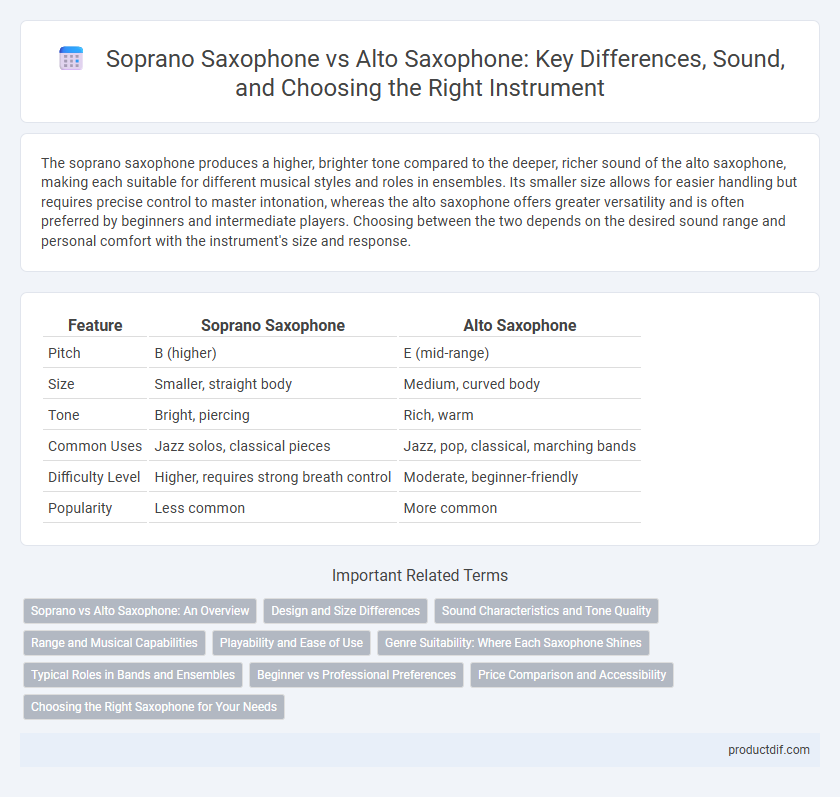The soprano saxophone produces a higher, brighter tone compared to the deeper, richer sound of the alto saxophone, making each suitable for different musical styles and roles in ensembles. Its smaller size allows for easier handling but requires precise control to master intonation, whereas the alto saxophone offers greater versatility and is often preferred by beginners and intermediate players. Choosing between the two depends on the desired sound range and personal comfort with the instrument's size and response.
Table of Comparison
| Feature | Soprano Saxophone | Alto Saxophone |
|---|---|---|
| Pitch | B (higher) | E (mid-range) |
| Size | Smaller, straight body | Medium, curved body |
| Tone | Bright, piercing | Rich, warm |
| Common Uses | Jazz solos, classical pieces | Jazz, pop, classical, marching bands |
| Difficulty Level | Higher, requires strong breath control | Moderate, beginner-friendly |
| Popularity | Less common | More common |
Soprano vs Alto Saxophone: An Overview
The soprano saxophone features a higher pitch and straighter design compared to the curved, lower-pitched alto saxophone, affecting tonal quality and playability. Soprano saxophones are typically tuned in B, producing bright, piercing sounds ideal for jazz solos, while alto saxophones, pitched in E, offer a richer, mellower tone suited for various musical genres. Differences in size, finger spacing, and embouchure requirements make the soprano saxophone more challenging for beginners, whereas the alto saxophone remains a popular choice for intermediate players due to its versatility.
Design and Size Differences
The soprano saxophone features a straight or slightly curved design and is smaller in size compared to the alto saxophone, which has a distinctive curved body and larger frame. The soprano's compact design allows for higher pitch ranges, while the alto's larger size produces a richer, deeper sound. These design and size differences directly influence the playing technique and tonal characteristics of each instrument.
Sound Characteristics and Tone Quality
The soprano saxophone produces a bright, piercing sound with a clear and penetrating tone, ideal for melodic leads and higher registers. In contrast, the alto saxophone offers a warmer, richer tone with a broader dynamic range, making it versatile across jazz, classical, and popular music. Both instruments share similar fingerings, but their distinct timbres are crucial in defining their unique roles within ensembles.
Range and Musical Capabilities
The soprano saxophone, pitched in B, offers a higher range typically spanning from A3 to E6, producing a bright, piercing tone ideal for melodic solos and jazz improvisation. The alto saxophone, pitched in E, covers a wider range from D3 to A5, delivering a richer, fuller sound suited for ensemble settings and versatile genres. Both instruments exhibit distinct tonal qualities and range capabilities that influence their use in classical, jazz, and contemporary music compositions.
Playability and Ease of Use
The soprano saxophone offers a higher pitch and requires precise embouchure control, making its playability more challenging for beginners compared to the alto saxophone. The alto saxophone, with a larger mouthpiece and more forgiving finger spacing, is widely regarded for easier sound production and greater comfort during extended practice. Musicians often find the alto saxophone more accessible for developing tone quality and dexterity in early learning stages.
Genre Suitability: Where Each Saxophone Shines
The soprano saxophone excels in jazz and classical music due to its bright, piercing tone that complements melodic solos and intricate passages. The alto saxophone is highly versatile, thriving in jazz, rock, pop, and orchestral settings because of its rich, warm sound and balanced range. Each saxophone's unique timbre and tonal qualities determine its genre suitability, with soprano favored for expressive, high-register playing and alto preferred for its adaptability across diverse musical styles.
Typical Roles in Bands and Ensembles
The soprano saxophone typically carries melodic lines and higher-pitched solos in jazz bands, concert bands, and chamber ensembles, adding a bright, piercing tone. The alto saxophone often plays harmonic support and counter-melodies in big bands and school ensembles, offering a versatile mid-range voice that blends well with brass and woodwinds. Both instruments contribute distinct sonic colors, with the soprano saxophone emphasizing lyrical phrasing and the alto saxophone providing rich tonal foundation in ensemble settings.
Beginner vs Professional Preferences
The soprano saxophone offers a higher pitch and brighter tone, often preferred by professionals for jazz or solo performances due to its challenging fingerings and intonation control. In contrast, beginner saxophonists typically choose the alto saxophone because of its more manageable size, ease of play, and versatility across musical genres. Professional saxophonists may switch between soprano and alto saxophones to exploit different tonal qualities and expand their artistic expression.
Price Comparison and Accessibility
The soprano saxophone generally commands a higher price than the alto saxophone due to its specialized design and lower production volume, making it less accessible to beginners or budget-conscious buyers. Alto saxophones are widely available with a broad price range, from affordable student models to professional instruments, enhancing their accessibility for learners. This price disparity influences purchasing decisions, with the alto saxophone often favored for its balance of cost, availability, and versatility.
Choosing the Right Saxophone for Your Needs
Choosing the right saxophone depends on your musical style, range preference, and physical comfort. The soprano saxophone offers a higher pitch and brighter tone, ideal for jazz and classical solos, while the alto saxophone provides a versatile mid-range sound suited for beginners and ensemble playing. Consider the soprano's smaller size and more challenging finger placement versus the alto's balanced weight and easier breath control for optimal performance and enjoyment.
Soprano Saxophone vs Alto Saxophone Infographic

 productdif.com
productdif.com